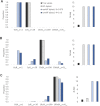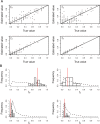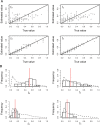Inferring the distribution of fitness effects in patient-sampled and experimental virus populations: two case studies
- PMID: 34987185
- PMCID: PMC8728706
- DOI: 10.1038/s41437-021-00493-y
Inferring the distribution of fitness effects in patient-sampled and experimental virus populations: two case studies
Abstract
We here propose an analysis pipeline for inferring the distribution of fitness effects (DFE) from either patient-sampled or experimentally-evolved viral populations, that explicitly accounts for non-Wright-Fisher and non-equilibrium population dynamics inherent to pathogens. We examine the performance of this approach via extensive power and performance analyses, and highlight two illustrative applications - one from an experimentally-passaged RNA virus, and the other from a clinically-sampled DNA virus. Finally, we discuss how such DFE inference may shed light on major research questions in virus evolution, ranging from a quantification of the population genetic processes governing genome size, to the role of Hill-Robertson interference in dictating adaptive outcomes, to the potential design of novel therapeutic approaches to eradicate within-patient viral populations via induced mutational meltdown.
© 2021. The Author(s), under exclusive licence to The Genetics Society.
Conflict of interest statement
The authors declare no competing interests.
Figures




Similar articles
-
The evolutionarily stable distribution of fitness effects.Genetics. 2015 May;200(1):321-9. doi: 10.1534/genetics.114.173815. Epub 2015 Mar 10. Genetics. 2015. PMID: 25762525 Free PMC article.
-
The distribution of mutational effects on fitness in Caenorhabditis elegans inferred from standing genetic variation.Genetics. 2022 Jan 4;220(1):iyab166. doi: 10.1093/genetics/iyab166. Genetics. 2022. PMID: 34791202 Free PMC article.
-
Inferring Genome-Wide Correlations of Mutation Fitness Effects between Populations.Mol Biol Evol. 2021 Sep 27;38(10):4588-4602. doi: 10.1093/molbev/msab162. Mol Biol Evol. 2021. PMID: 34043790 Free PMC article.
-
Effects of new mutations on fitness: insights from models and data.Ann N Y Acad Sci. 2014 Jul;1320(1):76-92. doi: 10.1111/nyas.12460. Epub 2014 May 30. Ann N Y Acad Sci. 2014. PMID: 24891070 Free PMC article. Review.
-
Emergency Services of Viral RNAs: Repair and Remodeling.Microbiol Mol Biol Rev. 2018 Mar 14;82(2):e00067-17. doi: 10.1128/MMBR.00067-17. Print 2018 Jun. Microbiol Mol Biol Rev. 2018. PMID: 29540453 Free PMC article. Review.
Cited by
-
Developing an appropriate evolutionary baseline model for the study of SARS-CoV-2 patient samples.PLoS Pathog. 2023 Apr 5;19(4):e1011265. doi: 10.1371/journal.ppat.1011265. eCollection 2023 Apr. PLoS Pathog. 2023. PMID: 37018331 Free PMC article. Review.
-
The effects of mutation and recombination rate heterogeneity on the inference of demography and the distribution of fitness effects.bioRxiv [Preprint]. 2023 Nov 13:2023.11.11.566703. doi: 10.1101/2023.11.11.566703. bioRxiv. 2023. Update in: Genome Biol Evol. 2024 Feb 1;16(2):evae004. doi: 10.1093/gbe/evae004 PMID: 38014252 Free PMC article. Updated. Preprint.
-
The Effects of Mutation and Recombination Rate Heterogeneity on the Inference of Demography and the Distribution of Fitness Effects.Genome Biol Evol. 2024 Feb 1;16(2):evae004. doi: 10.1093/gbe/evae004. Genome Biol Evol. 2024. PMID: 38207127 Free PMC article.
References
-
- Bank C, Ewing GB, Ferrer-Admettla A, Foll M, Jensen JD. Thinking too positive? Revisiting current methods of population genetic selection inference. Trends Genet. 2014;30(12):540–546. - PubMed
-
- Bank C, Renzette N, Liu P, Matuszewski S, Shim H, Foll M, et al. An experimental evaluation of drug-induced mutational meltdown as an antiviral treatment strategy. Evolution. 2016;70(11):2470–2484. - PubMed
Publication types
MeSH terms
Grants and funding
LinkOut - more resources
Full Text Sources

